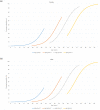Fifteen-year trajectories of multimorbidity and polypharmacy in Dutch primary care-A longitudinal analysis of age and sex patterns
- PMID: 35213615
- PMCID: PMC8880753
- DOI: 10.1371/journal.pone.0264343
Fifteen-year trajectories of multimorbidity and polypharmacy in Dutch primary care-A longitudinal analysis of age and sex patterns
Abstract
Objective: After stratifying for age, sex and multimorbidity at baseline, our aim is to analyse time trends in incident multimorbidity and polypharmacy in the 15-year clinical trajectories of individual patients in a family medicine setting.
Methods: This study was carried out using data from the Registration Network Family Medicine in the South of the Netherlands. The clinical trajectories of 10037 subjects during the 15-year period (2000-2014) were analyzed in a repeated measurement of using a generalized estimating equations model as well as a multilevel random intercept model with repeated measurements to determine patterns of incident multimorbidity and polypharmacy. Hierarchical age-period-cohort models were used to generate age and cohort trajectories for comparison with prevalence trends in multimorbidity literature.
Results: Multimorbidity was more common in females than in males throughout the duration of the 15-year trajectory (females: 39.6%; males: 33.5%). With respective ratios of 11.7 and 5.9 between the end and the beginning of the 15-year period, the youngest female and male groups showed a substantial increase in multimorbidity prevalence. Ratios in the oldest female and male groups were 2.2 and 1.9 respectively. Females had higher levels of multimorbidity than males in the 0-24-year and 25-44-year age groups, but the levels converged to a prevalence of 92.2% in the oldest male and 90.7% in the oldest female group. Similar, albeit, moderate differences were found in polypharmacy patterns.
Conclusions: We sought to specify the progression of multimorbidity from an early age. As a result, our study adds to the multimorbidity literature by specifying changes in chronic disease accumulation with relation to polypharmacy, and by tracking differences in patient trajectories according to age and sex. Multimorbidity and polypharmacy are common and their prevalence is accelerating, with a relatively rapid increase in younger groups. From the point of view of family medicine, this underlines the need for a longitudinal approach and a life course perspective in patient care.
Conflict of interest statement
The authors have declared that no competing interests exist.
Figures






References
-
- Van den Akker M, Buntinx F, Knottnerus JA. Comorbidity or multimorbidity: what’s in a name. A review of literature. Eur J Gen Pract 1996;2:65–70.
MeSH terms
LinkOut - more resources
Full Text Sources
Research Materials

